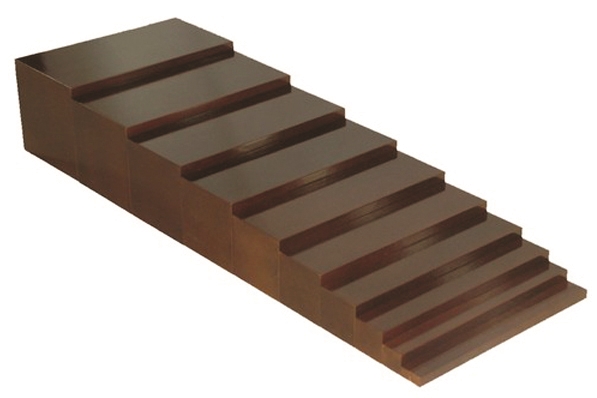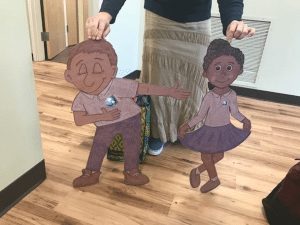Montessori School Brown Stair
The Montessori School Brown Stair, or the Broad Stair, is meant to develop the child’s awareness of size difference. All ten blocks are the same length, but they vary in both length and depth. This material trains both the eye and the hand to discriminate and compare between wide and narrow.
What is the Montessori School Brown Stair?
The Brown Stair is made up of ten brown, wooden rectangular prisms. The end faces graduate from 1 centimeter squared to 10 centimeters (one decimeter) squared. All ten prisms have a length of 20 centimeters.
The Brown Stair is part of the Visual Sensorial curriculum. It allows children to see a growing scale while reinforcing this observation with the sense of touch.
As with all Montessori school materials, a single variable is isolated. All other variables remain the same. The blocks are all the same length, color, and material. This way, the focus on wide and narrow is apparent. Many so-called educational toys attempt to pack in as much as possible in one material. Blocks come in varying colors with different designs on them. In truth, that kind of overstimulation distracts the young child’s mind. Simpler materials like the Brown Stair better tap into little ones’ innate desire to make sense of their world.
Working With the Montessori School Brown Stair
To work with the Brown Stair, the child brings each prism to a floor mat. She arranges the prisms from thickest to thinnest, using her hands to ensure that the ends are flush. When grasping a prism, the child’s hand wraps around its thickness to bring attention to this dimension. The Montessori Guide’s role is to help encourage the child to figure it out.
As the child masters this exercise, the next step is introduced. At this level, she arranges the stair and then brings the smallest prism up against each step, observing the growing comparison scale. Later, children are free to explore with the Brown Stair and the Pink Tower, discovering how they relate to one another.
All Montessori works have a control of error. If the child places a block incorrectly, it will become apparent at the end when it is leftover. Young learners can self-correct this way. This empowers them to direct their own learning. There is no need for adult interference when a child makes a mistake working with the Brown Stair.
Montessori School Brown Stair Vocabulary
When working with the Brown Stair, children should be taught to use the words “wide’ and “narrow”, the comparative terms “wider” and “narrower”, and the superlative terms “widest” and “narrowest”. A three-part lesson should be presented if they need it. For example, laying out three blocks, the teacher might point to each block and say, “This is wide. This is narrower. This is narrowest.” Next, she’d ask the learner to point to “wide,” “narrower,” and “narrowest.” Finally, she’d ask leading questions where the child would reply with the correct terms.
Does the Brown Stair Have To Be Brown?
Montessori materials are designed to isolate one variable, so the Brown Stair (Broad Stair) could come in a different color, as long as that color was consistent throughout all of the blocks. However, ideally, every material should be as Maria Montessori originally designed it. She was very intentional about the sizes and colors she chose, basing them off what she knew about child development.
Changing the color might not make a huge difference in a child’s learning, but changing the overall size or weight could. Mini-versions of Montessori materials, including the Brown Stair, are available to purchase, but they are not ideal. Montessori created the early sensorial materials to bring the child’s awareness to distinctions in size. Part of understanding the difference between one and ten comes from holding something ten times longer and heavier than something else.
The Brown Stair is appropriate for children ages 2.5-3.5.


